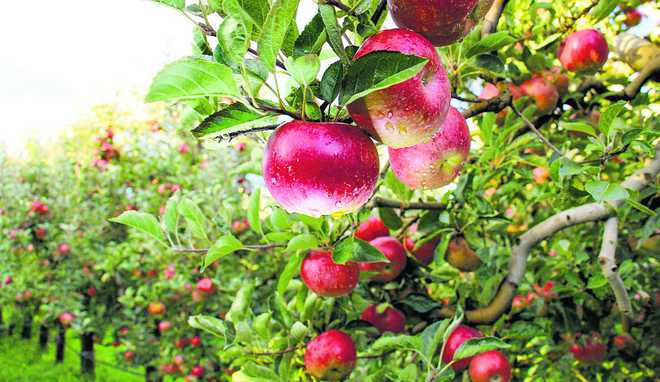
Himachal Pradesh, endowed with enormous natural beauty and resources, is known as apple state. Due to varied agro climatic conditions large variety of fruits such as apple, peach, plum, apricot, pear, cherries, mango, guava, citrus, papaya, grapes, litchi, aonla, almond, walnut, pecan nut and vegetables are grown in the state. Fruit crops occupy an area of 2.29 lakh hectare with total production of 6.12 lakh MT, while vegetables are grown in an area of 93,120 hectare with total production of about 17.84 lakh MT in the state.
Apple is the most dominant fruit crop grown in 48.81 per cent area (1.12 lakh hectare) with 76.50 per cent (4.68 lakh MT) production. Besides, the state produces fruits like peach, plum, apricot, pear, cherries, mangoes, kinnows, galgal, limes, guava, litchi, papaya, grapes, nuts and dry fruits. Although large quantity of fruits and vegetables are marketed as fresh, a substantial quantity goes waste due to non-availability of infrastructure for post-harvest management, processing and value addition.
In respect of post-harvest management infrastructure, Himachal Pradesh has 11 packaging and grading houses, five cold storages each having 1,000 MT of capacity in different parts of the state. At Parwanoo (Solan), there is one cold storage unit with 3,000 MT of capacity. There are three terminal markets having capacity of total 8,250 MT, besides there are three transit warehouses for handling apple. With respect to processing and value addition, there are about 129 FPO licensed processing units with an installed processing capacity of only 0.83 lakh MT. The capacity utilisation is, however, very meager due to various reasons. In lower shiwaliks and sub-tropical areas fruits like mangoes especially in-situ mangoes, hill lemon (galgal), papayas, kagji lime, ber, karonda, harar, behera and aonla are grown abundantly and need to be processed into different value-added products.
On an average, one-third of the produce is wasted right from the harvest till its consumption. Fresh produce that cannot be traded due to the glut can be profitably utilised as value-added products such as pulps, juices, ready to serve drinks, squashes, juice concentrates, juice-based carbonated drinks, dried/dehydrated products, pickles, sauces, preserves, candies, fermented beverages like cider, wine, vinegar.
There is a need for establishment of processing units in growing areas for processing of locally available produce into dried products, pulps and raw juices and their conversion into finished products (jam, squash, pickle, chutney, ready-to-serve drinks, concentrate etc). Establishment of one unit in each block for making semi-finished products like raw slices, pulps and juices near to growing area and their conversion into finished product in large-scale processing plant at a centralised place (one in each district) shall help in reducing the post-harvest losses and wastage.
Further, industries based on multi-product processing shall be useful to run the unit throughout the year to make best use of the installed capacity. Harnessing solar energy in processing by establishing solar dryers in growing catchments shall be helpful in drying of different fruit and vegetables. Fruit products having health promoting properties like aloe vera, harar, aonla, low-calories beverages, papaya leaf extract-based drinks to improve platelet counts in dengue fever, juice/pulp powders need to be developed and popularised to make use of abundantly available fruits and vegetables.
Even after processing, large quantity of waste in the form of pomace, seeds, and peel is generated, which can also be utilised for making products like pectin, dietary fibre and alcohol from pomace, oil from kernels, facial etc for which appropriate industry can be established. Keeping in view the availability of raw material, there is a great scope for processing of fruit and vegetables into different products to reduce wastage, to achieve sustainability of small holdings, increase employment, provide enormous export potential, achieving nutrition security and improving environment.
— Dean, College of Horticulture & Forestry, Dr YSP University of Horticulture & Forestry, HP



























